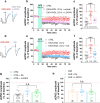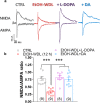Dopamine Restores Limbic Memory Loss, Dendritic Spine Structure, and NMDAR-Dependent LTD in the Nucleus Accumbens of Alcohol-Withdrawn Rats
- PMID: 30446531
- PMCID: PMC6382989
- DOI: 10.1523/JNEUROSCI.1377-18.2018
Dopamine Restores Limbic Memory Loss, Dendritic Spine Structure, and NMDAR-Dependent LTD in the Nucleus Accumbens of Alcohol-Withdrawn Rats
Abstract
Alcohol abuse leads to aberrant forms of emotionally salient memory, i.e., limbic memory, that promote escalated alcohol consumption and relapse. Accordingly, activity-dependent structural abnormalities are likely to contribute to synaptic dysfunctions that occur from suddenly ceasing chronic alcohol consumption. Here we show that alcohol-dependent male rats fail to perform an emotional-learning task during abstinence but recover their functioning by l-3,4-dihydroxyphenylalanin (l-DOPA) administration during early withdrawal. l-DOPA also reverses the selective loss of dendritic "long thin" spines observed in medium spiny neurons of the nucleus accumbens (NAc) shell of alcohol-dependent rats during abstinence, as well as the reduction in tyrosine hydroxylase immunostaining and postsynaptic density-95-positive elements. Patch-clamp experiments in NAc slices reveal that both in vivo systemic l-DOPA administration and in vitro exposure to dopamine can restore the loss of long-term depression (LTD) formation, counteract the reduction in NMDAR-mediated synaptic currents and rectify the altered NMDAR/AMPAR ratio observed in alcohol-withdrawn rats. Further, in vivo microdialysis experiments show that blunted dopaminergic signaling is revived after l-DOPA treatment during early withdrawal. These results suggest a key role of an efficient dopamine signaling for maintaining, and restore, neural trophism, NMDA-dependent LTD, and ultimately optimal learning.SIGNIFICANCE STATEMENT Blunted dopamine signaling and altered glutamate connectivity in the nucleus accumbens represent the neuroanatomical basis for the impairment in aversive limbic memory observed during withdrawal in alcohol dependence. Supplying l-DOPA during withdrawal re-establishes synaptic morphology and functional neuroadaptations, suggesting a complete recovery of nucleus accumbens glutamatergic synaptic plasticity when dopamine is revived. Importantly, restoring dopamine transmission allows those synapses to encode emotionally relevant information and rescue flexibility in the neuronal circuits that process limbic memory formation. Under these conditions, drugs capable of selectively boosting the dopaminergic function during the "fluid" and still responsive state of the early withdrawn maladaptive synapses may help in the treatment of alcohol addiction.
Keywords: LTD; alcohol abuse; confocal microscopy; dopamine; glutamate; memory.
Copyright © 2019 the authors 0270-6474/19/390930-15$15.00/0.
Figures








Similar articles
-
Hampered long-term depression and thin spine loss in the nucleus accumbens of ethanol-dependent rats.Proc Natl Acad Sci U S A. 2014 Sep 2;111(35):E3745-54. doi: 10.1073/pnas.1406768111. Epub 2014 Aug 13. Proc Natl Acad Sci U S A. 2014. PMID: 25122682 Free PMC article.
-
Withdrawal from cocaine self-administration alters NMDA receptor-mediated Ca2+ entry in nucleus accumbens dendritic spines.PLoS One. 2012;7(8):e40898. doi: 10.1371/journal.pone.0040898. Epub 2012 Aug 3. PLoS One. 2012. PMID: 22870207 Free PMC article.
-
Endogenous dopamine and endocannabinoid signaling mediate cocaine-induced reversal of AMPAR synaptic potentiation in the nucleus accumbens shell.Neuropharmacology. 2018 Mar 15;131:154-165. doi: 10.1016/j.neuropharm.2017.12.011. Epub 2017 Dec 7. Neuropharmacology. 2018. PMID: 29225042 Free PMC article.
-
Differential striatal spine pathology in Parkinson's disease and cocaine addiction: a key role of dopamine?Neuroscience. 2013 Oct 22;251:2-20. doi: 10.1016/j.neuroscience.2013.07.011. Epub 2013 Jul 16. Neuroscience. 2013. PMID: 23867772 Free PMC article. Review.
-
Regulation of AMPA receptor trafficking in the nucleus accumbens by dopamine and cocaine.Neurotox Res. 2010 Nov;18(3-4):393-409. doi: 10.1007/s12640-010-9176-0. Epub 2010 Apr 2. Neurotox Res. 2010. PMID: 20361291 Free PMC article. Review.
Cited by
-
Therapeutic non-invasive brain treatments in Alzheimer's disease: recent advances and challenges.Inflamm Regen. 2022 Oct 3;42(1):31. doi: 10.1186/s41232-022-00216-8. Inflamm Regen. 2022. PMID: 36184623 Free PMC article. Review.
-
Impact of Pharmacological and Non-Pharmacological Modulators on Dendritic Spines Structure and Functions in Brain.Cells. 2021 Dec 2;10(12):3405. doi: 10.3390/cells10123405. Cells. 2021. PMID: 34943913 Free PMC article. Review.
-
Cognitive Alterations in Addictive Disorders: A Translational Approach.Biomedicines. 2023 Jun 23;11(7):1796. doi: 10.3390/biomedicines11071796. Biomedicines. 2023. PMID: 37509436 Free PMC article. Review.
-
Framework for internal sensation of pleasure using constraints from disparate findings in nucleus accumbens.World J Psychiatry. 2021 Oct 19;11(10):681-695. doi: 10.5498/wjp.v11.i10.681. eCollection 2021 Oct 19. World J Psychiatry. 2021. PMID: 34733636 Free PMC article.
-
Repeated exposure to JWH-018 induces adaptive changes in the mesolimbic and mesocortical dopaminergic pathways, glial cells alterations, and behavioural correlates.Br J Pharmacol. 2021 Sep;178(17):3476-3497. doi: 10.1111/bph.15494. Epub 2021 Jun 29. Br J Pharmacol. 2021. PMID: 33837969 Free PMC article.
References
Publication types
MeSH terms
Substances
LinkOut - more resources
Full Text Sources
Medical
